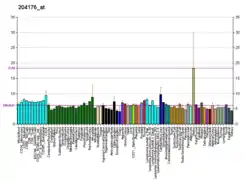Kelch-like protein 20
Kelch-like protein 20 is a protein that in humans is encoded by the KLHL20 gene.[5][6]
The protein encoded by this gene is a member of the kelch family of proteins, which is characterized by a 44-56 amino acid repeat motif. The kelch motif appears in many different polypeptide contexts and contains multiple potential protein-protein contact sites. Members of this family are present both throughout the cell and extracellularly, with diverse activities.[6]
References
- GRCh38: Ensembl release 89: ENSG00000076321 - Ensembl, May 2017
- GRCm38: Ensembl release 89: ENSMUSG00000026705 - Ensembl, May 2017
- "Human PubMed Reference:". National Center for Biotechnology Information, U.S. National Library of Medicine.
- "Mouse PubMed Reference:". National Center for Biotechnology Information, U.S. National Library of Medicine.
- Hara T, Ishida H, Raziuddin R, Dorkhom S, Kamijo K, Miki T (Mar 2004). "Novel kelch-like protein, KLEIP, is involved in actin assembly at cell-cell contact sites of Madin-Darby canine kidney cells". Mol Biol Cell. 15 (3): 1172–84. doi:10.1091/mbc.E03-07-0531. PMC 363103. PMID 14668487.
- "Entrez Gene: KLHL20 kelch-like 20 (Drosophila)".
Further reading
- Adams J, Kelso R, Cooley L (2000). "The kelch repeat superfamily of proteins: propellers of cell function". Trends Cell Biol. 10 (1): 17–24. doi:10.1016/S0962-8924(99)01673-6. PMID 10603472.
- Nemes JP, Benzow KA, Moseley ML, et al. (2000). "The SCA8 transcript is an antisense RNA to a brain-specific transcript encoding a novel actin-binding protein (KLHL1)". Hum. Mol. Genet. 9 (10): 1543–51. doi:10.1093/hmg/9.10.1543. PMID 10888605.
- Strausberg RL, Feingold EA, Grouse LH, et al. (2003). "Generation and initial analysis of more than 15,000 full-length human and mouse cDNA sequences". Proc. Natl. Acad. Sci. U.S.A. 99 (26): 16899–903. Bibcode:2002PNAS...9916899M. doi:10.1073/pnas.242603899. PMC 139241. PMID 12477932.
- Shin BK, Wang H, Yim AM, et al. (2003). "Global profiling of the cell surface proteome of cancer cells uncovers an abundance of proteins with chaperone function". J. Biol. Chem. 278 (9): 7607–16. doi:10.1074/jbc.M210455200. PMID 12493773.
- Ota T, Suzuki Y, Nishikawa T, et al. (2004). "Complete sequencing and characterization of 21,243 full-length human cDNAs". Nat. Genet. 36 (1): 40–5. doi:10.1038/ng1285. PMID 14702039.
- Gerhard DS, Wagner L, Feingold EA, et al. (2004). "The status, quality, and expansion of the NIH full-length cDNA project: the Mammalian Gene Collection (MGC)". Genome Res. 14 (10B): 2121–7. doi:10.1101/gr.2596504. PMC 528928. PMID 15489334.
- Gregory SG, Barlow KF, McLay KE, et al. (2006). "The DNA sequence and biological annotation of human chromosome 1". Nature. 441 (7091): 315–21. Bibcode:2006Natur.441..315G. doi:10.1038/nature04727. PMID 16710414.
- Nacak TG, Alajati A, Leptien K, et al. (2007). "The BTB-Kelch protein KLEIP controls endothelial migration and sprouting angiogenesis". Circ. Res. 100 (8): 1155–63. doi:10.1161/01.RES.0000265844.56493.ac. PMID 17395875.
This article is issued from Wikipedia. The text is licensed under Creative Commons - Attribution - Sharealike. Additional terms may apply for the media files.






